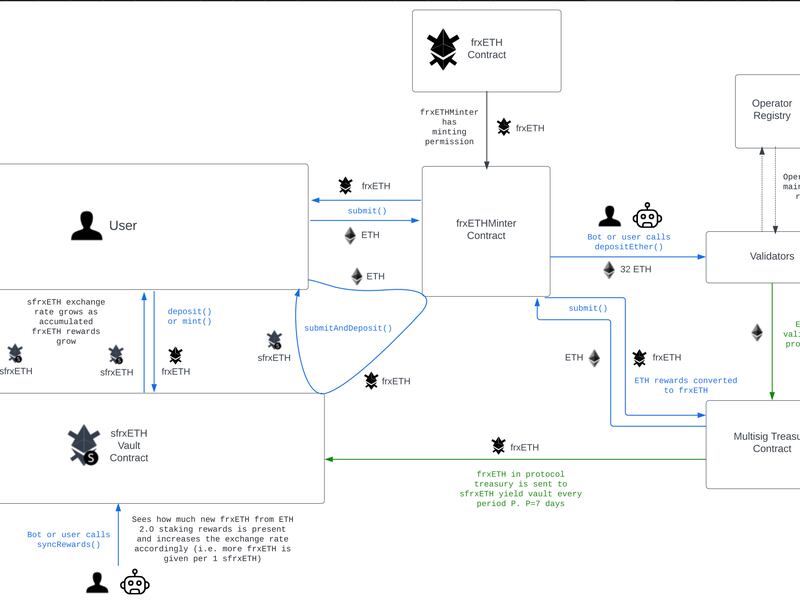Stablecoin Issuer Frax Finance Unveils Ether Staking Service With a Dual Token Model

Decentralized stablecoin issuer Frax Finance has entered the ether liquid staking war with a unique two-token model that supposedly allows users to earn above-average staking yields.
Called Frax Ether, the liquid staking system, went live on Oct. 13 in a soft community launch with an official announcement expected soon. The system has three components – frax ether (frxETH), staked frax Ether (sfrxETH), and the Frax ETH Minter. Staking refers to locking up coins in a crypto wallet in return for rewards. Liquid staking is the process of locking up funds to earn rewards while still having access to the funds locked via their liquid derivative coins.
The Frax ether token is an ether-pegged stablecoin meant to be equate to 1 ether (ETH). Users can deposit ETH into the Frax ETH Minter contract and get an equivalent amount of frxETH, unlocking the liquidity of ether staked. The frxETH tokens can be used to provide liquidity on the decentralized exchange Curve. However, to earn rewards on the ether staked, users need to exchange frxETH with the staked frax ether or sfrxETH tokens.
That's the critical difference between Frax and Lido, which owns more than 70% of the liquid staking derivative market. Lido has only one token called staked ether (stETH), which can be used elsewhere to generate additional yield. The stETH is a "rebasing token" with supply algorithmically adjusted to keep its price in line with ether's price. In other words, stETH holders earn rewards in the form of new stETH tokens and not in the form of appreciated stETH value.
The problem with stETH is that some decentralized finance (DeFi) protocols do not support rebasing tokens natively. So stETH holders risk losing out on a portion of daily staking rewards if they provide stETH as liquidity across such platforms. Therefore, stETH holders often have to wrap their liquid derivative tokens, creating a DeFi-compatible version.
Frax Finance's two-token model eliminates risks associated with rebasing and simplifies DeFi integrations. The frxETH stablecoin does not rebase and is fully backed by algorithmic market operations plus ether. Further, the sfrxETH tokens, which earn staking rewards, increase in price like the Yearn vault token.
"Lido has just one token because it rebases to reflect staking rewards. It breaks a lot of DeFi functionality. We don't want that, so we have opted for two tokens that can be used as DeFi primitives," Sam Kazemian, founder of Frax Finance, told CoinDesk.
"If you want an interest-bearing increasing token as like lending collateral, you would use sfrxETH, which is the staked version. If you just want a DeFi primitive, you can use frxETH," Kazemian added.
At press time, the total value locked in Frax Ether stood at $3.2 million, according to DefiLlama.

Maximizing yields
According to DeFi observer Shivanshu Madan, Frax's two-token model allows stakers to earn more than the average ether staking yield.
Let's look at a hypothetical example. Assume a trader named Bob deposits 100 ETH in the frxETH minter contract in return for 100 frxETH tokens.
The minter then locks the 100 ETH on Ethereum using a validator node. In the meantime, Bob deposits the 100 frxETH in the staked frax ether vault in return for 100 sfrxETH tokens.
Now assume the validator earns 10 ETH as the staking reward. It will send it back to the minter and get 10 frxETH, which is then sent to the staked frax ether vault, boosting its balance to 110 frxETH (100 deposited by Bob and 10 earned from staking).
In other words, Bob has earned a staking reward of 10 frxETH, which he can collect anytime by returning the 100 sfrxETH to the vault.
Deposit frxETH at different places
In the above example, assume that Bob sends only 60 frxETH to the staked frax ether vault and deposits the remaining 40 frxETH in the frxETH-ETH Curve pool.
In this case, the validator would still earn a yield on the initial deposit of 100 ETH, meaning the frax staked ether vault will hold 70 frxETH (60 deposited by Bob and 10 as rewards) when the rewards come through.
Meanwhile, Bob earns an additional yield, say five frxETH, for providing 40 frxETH on Curve. That takes the total return to 15 frxETH compared to 10 frxETH in the previous example.
The key point here is that return from providing liquidity on Curve needs to be higher than the staking yield.
The user, therefore, will have to find profitable strategies if he/she wants to earn "more than the average" staking yield, as Madan warned in a tweet thread.








